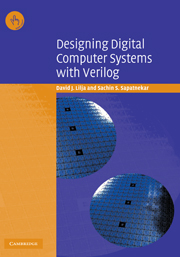Book contents
- Frontmatter
- Contents
- Preface
- 1 Controlling complexity
- 2 A Verilogical place to start
- 3 Defining the instruction set architecture
- 4 Algorithmic behavioral modeling
- 5 Building an assembler for VeSPA
- 6 Pipelining
- 7 Implementation of the pipelined processor
- 8 Verification
- A The VeSPA instruction set architecture (ISA)
- B The VASM assembler
- Index
- VeSPA Instruction Set
2 - A Verilogical place to start
Published online by Cambridge University Press: 31 October 2009
- Frontmatter
- Contents
- Preface
- 1 Controlling complexity
- 2 A Verilogical place to start
- 3 Defining the instruction set architecture
- 4 Algorithmic behavioral modeling
- 5 Building an assembler for VeSPA
- 6 Pipelining
- 7 Implementation of the pipelined processor
- 8 Verification
- A The VeSPA instruction set architecture (ISA)
- B The VASM assembler
- Index
- VeSPA Instruction Set
Summary
Let's start at the very beginning.
A very good place to start.
When you read, you begin with A-B-C,
when you sing, you begin with Do-Re-Mi.
from Rogers and Hammerstein's The Sound of MusicIn this chapter, we will present an elementary introduction to Verilog, with the primary aim of permitting the reader to learn enough of the language to carry out a competent design. Due to the scope of this text, we do not attempt to present complete coverage of the language; for example, we will not cover switch-level modeling concepts that are typically at the transistor-level, since the design of our processor does not require that level of design detail. For these and other details, the interested reader may refer to sources such as those shown in the Further reading section at the end of this chapter.
My Veri first description
In teaching an English-speaker a new tongue such as Spanish or Japanese or Marathi, two extreme approaches may be attempted. A more structured approach would lead the student through a rigorous path that first teaches the alphabet, followed by words, sentences and grammar; an alternative ‘immersive’ or ‘communicative’ approach places the student in an environment where the language is extensively spoken, in the hope that this may motivate learning in a more natural environment. In practice, of course, an intermediate approach is often the most effective, and we will use a similar philosophy in presenting a first exposition to the admittedly nonhuman language that is Verilog.
In this section, we will present a simple Verilog description of a very simple module.
- Type
- Chapter
- Information
- Designing Digital Computer Systems with Verilog , pp. 7 - 31Publisher: Cambridge University PressPrint publication year: 2004



